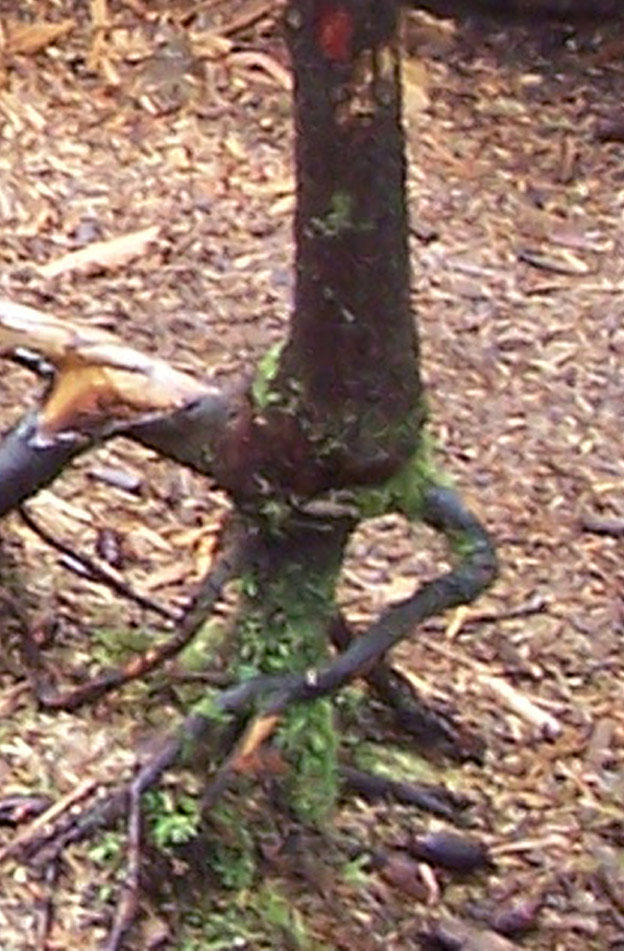

Finally – something else to do rather than post to the IAL blog! On to today’s photo (and I apologize for its blurriness).

The tree in this photo is alive, and as you can see has structural roots perched well above the soil. How might this have happened? There are multiple possibilities. And secondly, is there a negative impact on the tree, and if so, what? Answers and another photo on Monday!
Have a nice weekend!


Published by

Linda Chalker-Scott
Dr. Linda Chalker-Scott has a Ph.D. in Horticulture from Oregon State University and is an ISA certified arborist and an ASCA consulting arborist. She is WSU’s Extension Urban Horticulturist and an Emerita Professor in the Department of Horticulture. She conducts research in applied plant and soil sciences, publishing the results in scientific articles and university Extension fact sheets.
Linda also is the award-winning author of five books: the horticultural myth-busting The Informed Gardener (2008) and The Informed Gardener Blooms Again (2010) from the University of Washington Press and Sustainable Landscapes and Gardens: Good Science – Practical Application (2009) from GFG Publishing, Inc., and How Plants Work: The Science Behind the Amazing Things Plants Do from Timber Press (2015). Her latest effort is an update of Art Kruckeberg’s Gardening with Native Plants of the Pacific Northwest from UW Press (2019).
In 2018 Linda was featured in a video series – The Science of Gardening – produced by The Great Courses. She also is one of the Garden Professors – a group of academic colleagues who educate and entertain through their blog and Facebook pages. Linda’s contribution to gardeners was recognized in 2017 by the Association for Garden Communicators as the first recipient of their Cynthia Westcott Scientific Writing Award.
"The Garden Professors" Facebook group - www.facebook.com/groups/GardenProfessors
Books: http://www.sustainablelandscapesandgardens.com
View all posts by Linda Chalker-Scott

Looks like a slope behind the tree, a whole lot of wood chips, and quite a bit of root and trunk bark damage. Is that moss on the roots? MIght the chips, bark damage, and evident erosion be signs that this tree is in recently logged area, and was too small itself to be taken? Negative impacts might include mechanical instability, susceptibility to windthrow, and exposure to pathogens. If the feeder roots are intact, then the tree can probably live on as long as it can resist the mechanical problems.
Could it be there was a ‘Mulch Volcano’ up against the tree, with adventitious roots growing into it?
Stream bank erosion victim?
I would have thought erosion, however there also appears to be some sort of damage to the bark (is it called bark when it is on roots?). Is there excavation going on around or near it?
My first thought was volcano mulch, too.
I would guess by the moss that the roots have been exposed for some time. My guess (like a lot of other folks) is erosion. Second guess would be that the tree grew over/around something like a rock or debris that’s now been removed. The biggest danger I can think of is that it doesn’t have the stability of a “normal” tree and would be susceptible to blow-down. The solution’s bound to be interesting!
It might be that the tree was planted in a man-made soil. I once saw a Melbourne council verge on which they had brought in landscaping soil to create a sloping effect. Within about three years the high organic matter content of the original soil had broken down significantly, leading to a drop in the original soil level by over a foot. No soil had been eroded or washed way, the drop in soil level was entirely due the organic components in the soil mix breaking down. This significantly exposed tree roots on the site, though not to the extent of the tree in the picture.
I’d be worried about how well the tree is anchored into the ground. It looks like the slightest bit of high wind would send it toppling over.
I have a birch tree that originally sprouted in a crack in a granite ledge. Years ago it fell, with roots intact, and rest on the ledge parallel to the ground. Since then it took a 90 degree turn, and now the trunk grows straight upward. The root system is not attached at it’s original location and it’s new location where it resembles your photo. With the tree still relatively small, we keep it as a conversation piece, but it will eventually have to come down. Could your tree be growing against
a ledge?
I too am voting for erosion based on what appears to be a pile of soggy wood chip mulch in the background. The damage on the roots reminds me of constant foot traffic and there looks like there could be a red blaze on the top of the trunk. I’m guessing this is by a foot/bike trail. No guesses as to the future of the tree though 🙂
I’m answering a little late in the game. I also believe that the tree has suffered from erosion. I’m going to guess that a small sapling was toppled over during the logging process. And that the sapling essentially “layered” itself by putting out roots. And then over time the roots were exposed due to erosion. The picture looks like there is a large piece coming in from the left and then a large “joint” above the roots.